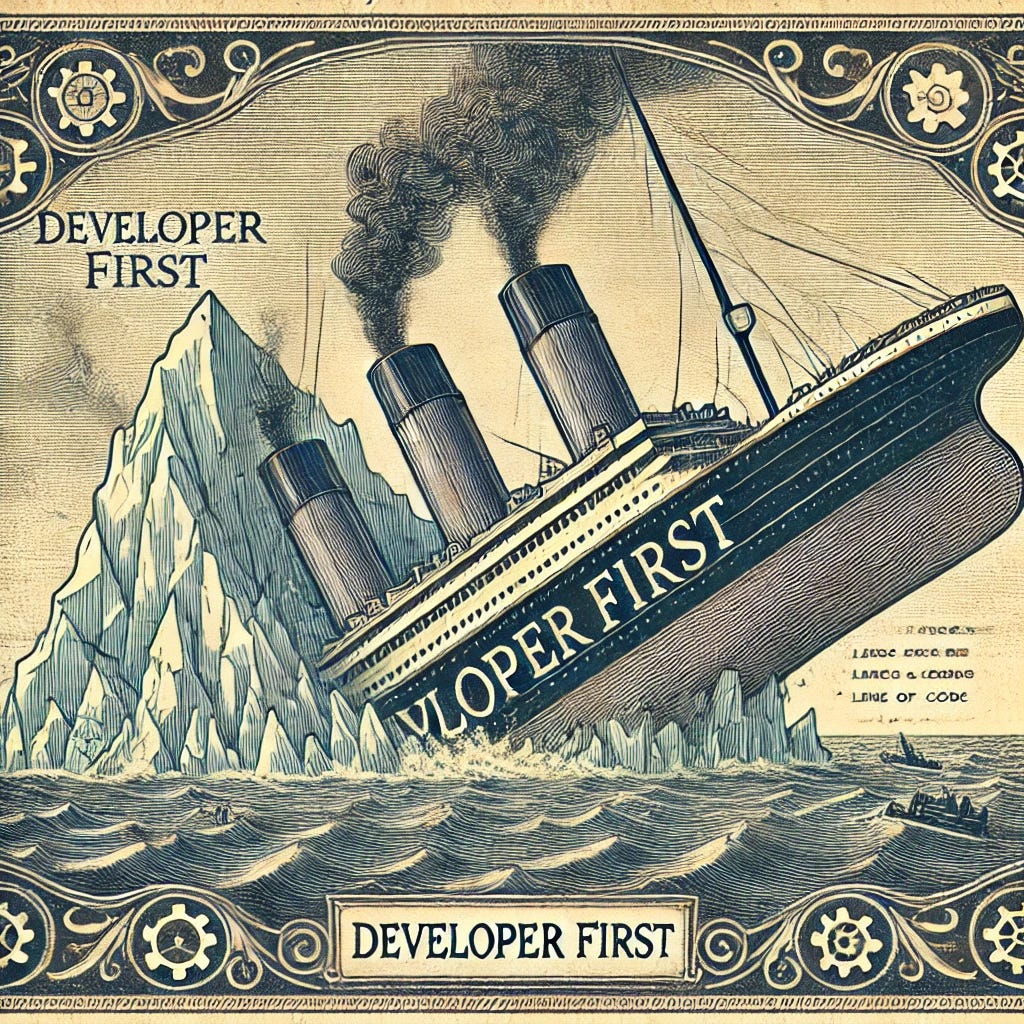Many years ago, my girlfriend worked at the Titanic Exhibition in Sevilla. One day, while waiting to pick her up, she handed me a free pass. I wasn’t exactly eager, but I went. Inside, I found eerie recreations—real artifacts, harrowing stories, and even a replica iceberg with desperate handprints. It was disturbingly vivid. By the end, I felt uneasy and overwhelmed.
Fast forward to today, and I hear struggling SaaS startups everywhere described as “Titanic-like.” While nobody’s drowning (yet), the feeling fits: icy waters, visible danger, and leadership steering straight for disaster.
For developer-first companies, this risk is magnified. These are companies building tools specifically for software developers—the crew steering the ship, not just passengers along for the ride. Developers influence decisions about which tools their organizations adopt, often bypassing traditional sales processes. They won’t buy tickets based on polished menus or shiny decks—they’ll evaluate whether your ship is seaworthy, reliable, and fast. If not? They jump ship before you even leave the dock.
And much like Captain Smith ignoring iceberg warnings, too many developer-first companies crash anyway—usually because they misunderstand their unique waters.
Developer-first Products: A different kind of ship
Unlike most enterprise SaaS, developer-first products target users who care deeply about how the product works, not just what it does. Developers don’t manage budgets, but they influence purchasing by demanding tools that solve real problems and make their lives easier. Winning them over requires exceptional technical quality, seamless onboarding, and a stellar developer experience (DX).
Your ship isn’t the sales pitch—it’s the APIs, SDKs, integrations, and documentation. A slick sales deck or decision-maker dinner won’t save you if your APIs are buggy or your onboarding takes longer than setting up Kubernetes…
Developer-first SaaS is unique: the product must win over users and translate into organizational value. Balancing these is tough. That’s where the Sales-Led Growth vs. Product-Led Growth debate often derails companies.
SLG vs. PLG: The Iceberg Debate
When scaling a SaaS business, two strategies dominate the conversation:
Sales-Led Growth (SLG): Building a sales team to convince decision-makers to buy your product.
Product-Led Growth (PLG): Letting users—often developers in this case—experience the product firsthand, then naturally upgrade as they see value.
Each approach has strengths, but for developer-first SaaS, both come with risks.
For example, imagine the Titanic in icy waters. The captain sees the looming iceberg, knows the risks, but prioritizes what’s right in front of them—smoothing relations with passengers, overstocking the bar, or printing more fancy menus. That’s your Sales-Led Growth (SLG) model: a short-sighted focus on immediate sales at the expense of long-term sustainability.
Sales-Led Growth pitfalls
In traditional Enterprise SaaS, Sales-Led Growth (SLG) works by wooing decision-makers with promises of ROI. In developer-first SaaS, this strategy often backfires. Developers hate being sold to and trust their peers over your sales team.
Common missteps include:
Disconnect from users: Prioritizing sales-driven features (or frameworks) over developer needs leads to frustration.
Fail to scale: Expanding a sales team to “cover more ground” is inefficient if your product doesn’t inspire advocacy.
Alienate developers: Developers want tools, not pitches. Targeting them with aggressive sales can kill deals—especially when their feedback isn’t considered.
I have seen deals being killed in the finish line just because the lead Architect thought the programming language they would have to adopt would make them look like losers….
Here’s the truth: Developers want a tool that makes their work easier, boosts productivity, and earns them kudos on GitHub. Sales-led strategies ignore these signals and, in doing so, alienate the very users who could drive growth.
Product-Led Growth pitfalls
Contrast this with a Product-Led Growth (PLG) ship, designed to let passengers (developers) explore the vessel themselves—finding value in its open layout, intuitive maps, and just in case, well-stocked lifeboats.
But it’s not unsinkable either. PLG fails when:
Freemium stalls revenue: Without a clear upgrade path, users linger in free tiers. Even great products often need a skilled salesperson to close larger deals.
Technical excellence falters: A buggy library or poor documentation can sink your product, no matter how enticing the trial.
Scaling DX breaks down: As users grow, maintaining smooth DX becomes exponentially harder—and there’s no salesperson to bail you out.
The truth? SLG and PLG alone can’t guarantee survival. Icebergs abound in both models.
The Hybrid Model: Product-Led Sales (PLS)
Here’s the dirty secret of the Titanic disaster: it wasn’t just about the iceberg. The ship's design—overhyped but underprepared—contributed just as much. Similarly, many B2B SaaS companies try to survive with either SLG or PLG, ignoring that the most seaworthy strategy often lies in combining both approaches.
Some call this Product-Led Sales (PLS).
It’s about knowing when to let developers explore the ship and when to bring in a skilled navigator (sales rep) to close the deal. The key is timing:
Let developers explore your product independently (PLG).
Use product signals—like API usage or team adoption rates—to guide targeted sales efforts (SLG).
The goal is Product-Qualified Accounts (PQA): whole teams engaged with your product. Sales then works to convert decision-makers a.k.a Product-Qualified Leads (PQLs) after developers have seen value.
PQLs won’t convert effectively without strong PQAs
Done right, Product-Led Sales turns developers into advocates, decision-makers into buyers, and your product into the hero of its own story. But even this hybrid model needs guardrails. In a nutshell:
Prioritize Developer Experience (DX) over Sales-driven feature factories
Balance sales timing with developer trust (refine product signals, clear handoff points, i.e., avoid premature sales intervention)
Iterate on pricing and conversion models (don’t be overly generous with your free tiers)
Let’s double click on some of these:
Building a stellar Developer Experience
Too many companies fall into the trap of building random features to close sales. It’s like installing a casino on the Titanic instead of reinforcing the hull.
This often leads to “feature factories”—teams churning out superficial additions that don't address core developer pain points.
Take Shopify. Developers often struggle with limited API flexibility when building customized storefronts. Or Commercetools, where modularity shines, but fragmented SDKs and inconsistent documentation turn the developer experience into a headache.
Therefore, developer-first SaaS companies should double down on:
Developer-centric APIs: Flexible, intuitive, and real-world ready.
Strong documentation: Clear guides, code samples, and sandbox environments.
Consistent SDKs: Reliable libraries across all supported languages.
Technical support: Forums, Slack communities, and troubleshooting channels—without requiring a support ticket.
The Stoic Captain’s Approach to Developer-first Growth
The Titanic's captain ignored the warnings. Don’t be that guy.
A Stoic approach to growth strategies means focusing on what you can control: building a product so compelling that developers want to champion it.
This includes:
Freemium Models: Allow developers to test core features for free and only charge for usage-based pricing like API calls or server capacity. This low-risk model puts control in developers' hands, allowing them to scale as they see value.
Self-Serve Onboarding: Developers want to start using the product without waiting for sales. Offer immediate access through free trials, paired with clear documentation and simple-to-use APIs and SDKs.
From Zero to Hero: Provide pre-built templates with backed-in integrations for common use cases so that they can scaffold super fast. They will become your best value ambassadors.
Start always with Product-Qualified Accounts (PQA): Monitor key product signals such as user engagement, adoption velocity, and behavioral cues like some user reviewing legal terms. These indicate when an account is ready for a sales conversation.
Sales feedback Loops: ensure sales and product teams are aligned over the cycle to feed the roadmap with the right value.
The goal isn't to eliminate Sales but to infuse PLG principles into the sales process.
Steer clear of the Iceberg
In developer-first enterprise SaaS, your success hinges on balance. The ship that wins is neither SLG nor PLG alone—it’s one that navigates both with precision, focusing on developer trust and product excellence.
Because in this industry, there are only two kinds of ships: the ones that adapt and sail—and the ones that hit icebergs.






